
Genus Hemicypris Sars, 1903
Superfamily: Cypridoidea Baird, 1845
Family: Cyprididae Baird, 1845
Subfamily: Cyprinotinae Bronstein, 1947
Six species have been reported from Japan:
1. Hemicypris barbadensis Broodbakker, 1983 
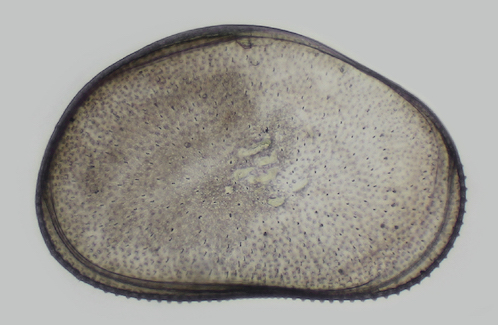
Internal view of a left valve of a female Hemicypris barbadensis. Length 1203 microns.
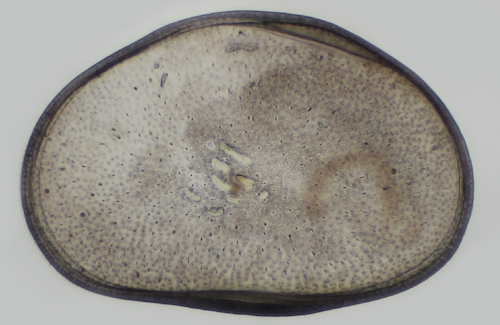
Internal view of a right valve of a female Hemicypris barbadensis. Length 1266 microns.
- Additional figures in: Broodbakker 1983; Okubo 2004 (as H. kawagaensis); Smith & Chang 2020.
- Habitat: Rice fields.
- Mode of life: Nektobenthic (swimmer).
- Reproduction mode: Asexual, males unknown.
- Known distribution: Kagawa Prefecture (Okubo 2004, as H. kawagaensis). Elsewhere, known Bardados (Broodbakker 1983), Jamaica (Holmes 1997) and Spain (Valls et al. 2014).
- Notes: Possibly an alien species in Japan (Smith & Chang 2020).
- References:
- ⚬ Broodbakker, N.W. 1983. The genus Hemicypris (Crustacea, Ostracoda) in the West Indies. Bijdragen tot de Dierkunde, 53, 135-157.
- ⚬ Holmes, J.A. 1997. Recent non-marine Ostracoda from Jamaica, West Indies. Journal of Micropalaeontology, 16, 137-143.
- ⚬ Okubo, I. 2004. Nihon tansui san kaimijinko rui ni tsuite. Kabushikigaisha Sanmon Insatsusho, Okayama, Japan, 72pp. [In Japanese, privately published].
- ⚬ Smith, R. J. & Chang, C. Y. 2020. Taxonomic assessments of some Cyprinotinae Bronstein, 1947 species (Crustacea: Ostracoda) from Japanese and Korean rice fields, including (re-) descriptions of six species and a review of the type species of the subfamily. Zootaxa, 4795 (1), 001-069.
- ⚬ Valls, L., Rueda, J. & Mesquita-Joanes, F. 2014. Rice fields as facilitators of freshwater invasions in protected wetlands: the case of Ostracoda (Crustacea) in the Albufera Natural Park (E Spain). Zoological Studies, 53, 1-10.
2. Hemicypris kaufmanni (Vávra, 1906) 
- Figures in: Vávra 1906 (as Cyprinotus (Hemicypris Sars G. O) kaufmanni).
- Habitat: A stoup in a temple.
- Mode of life: Nektobenthic (swimmer).
- Reproduction mode: Asexual, males unknown.
- Known distribution: Nagasaki Prefecture (Vávra 1906).
- Notes: Only one record of this species exists. This species needs to be redescribed.
- References:
- ⚬ Vávra, W. 1906. Ostracoden von Sumatra, Java, Siam, den Sandwich-Inseln und Japan. Zoologische Jahrbuecher Systematik, 23, 413-438, Pls. 24-25.
3. Hemicypris kibiensis Okubo, 1990 
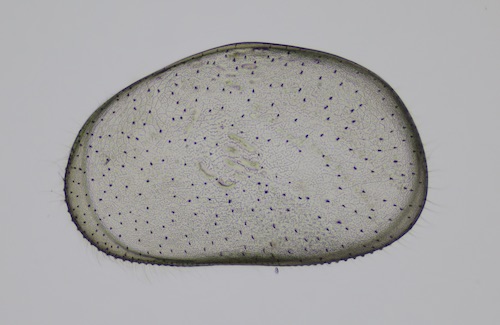
External view of a left valve of a female Hemicypris kibiensis. Length 890 microns.
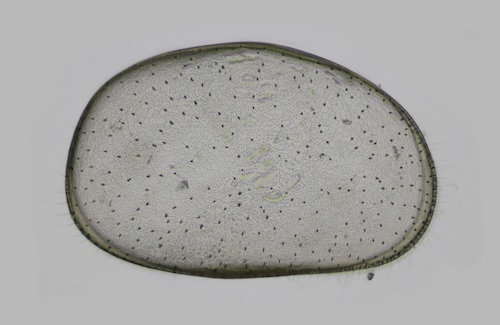
External view of a right valve of a female Hemicypris kibiensis. Length 913 microns.
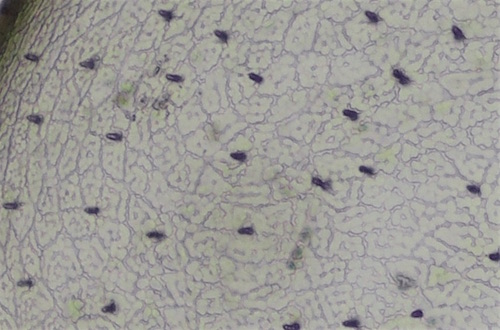
At high magnification, a reticulate pattern is visible on the valves. Width of view 263 microns.
- Additional figures in: Okubo 1990; Okubo 2004 (as Hemicypris megalops); Smith & Chang 2020.
- Habitat: Rice fields.
- Mode of life: Nektobenthic (swimmer).
- Reproduction mode: Asexual, males unknown.
- Known distribution: Okayama Prefecture.
- References:
- ⚬ Okubo, I. 1990. Seven new species of freshwater Ostracoda from Japan. Researches on Crustacea, 19, 1-12.
- ⚬ Okubo, I. 2004. Nihon tansui san kaimijinko rui ni tsuite. Kabushikigaisha Sanmon Insatsusho, Okayama, Japan, 72pp. [In Japanese, privately published].
- ⚬ Smith, R. J. & Chang, C. Y. 2020. Taxonomic assessments of some Cyprinotinae Bronstein, 1947 species (Crustacea: Ostracoda) from Japanese and Korean rice fields, including (re-) descriptions of six species and a review of the type species of the subfamily. Zootaxa, 4795 (1), 001-069.
4. Hemicypris mizunoi Okubo, 1990
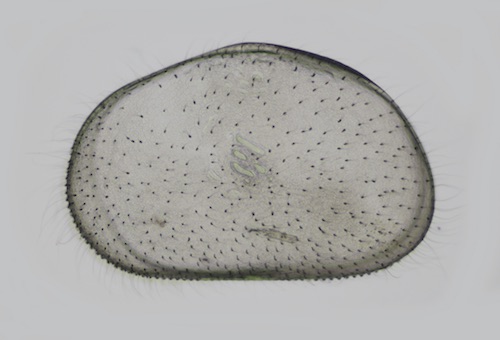
External view of a left valve of a female Hemicypris mizunoi. Length 935 microns.
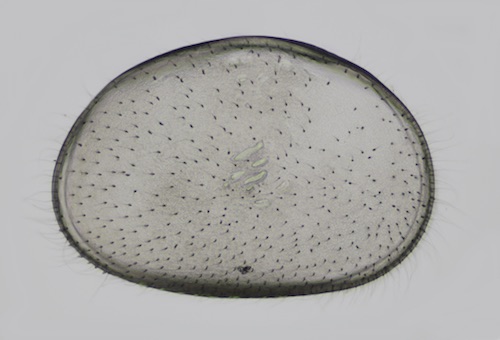
External view of a right valve of a female Hemicypris mizunoi. Length 972 microns.
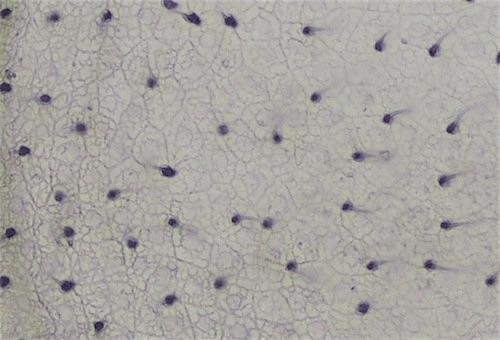
At high magnification, a reticulate pattern is visible on the valves. Width of view 248 microns.
- Additional figures in: Okubo 1990; Okubo 2004 (as Hemicypris pyxidata); Savatenalinton & Martens 2008.
- Habitat: Rice fields.
- Mode of life: Nektobenthic (swimmer).
- Reproduction mode: Asexual, males unknown.
- Known distribution: Okayama Prefecture (Okubo 1990). Elsewhere, Thailand (Savatenalinton & Martens 2008).
- Notes: Japanese specimens were first described as a new species, Hemicypris mizunoi Okubo, 1990, but were later considered to be a junior synonym of Hemicypris pyxidata (Moniez, 1892) by Okubo (2004). However, Savatenalinton & Martens (2008) considered H. mizunoi to differ from H. pyxidata, and re-described H. mizunoi using specimens collected from Thailand.
- References:
- ⚬ Okubo, I. 1990. Seven new species of freshwater Ostracoda from Japan. Researches on Crustacea, 19, 1-12.
- ⚬ Okubo, I. 2004. Nihon tansui san kaimijinko rui ni tsuite. Kabushikigaisha Sanmon Insatsusho, Okayama, Japan, 72pp. [In Japanese, privately published].
- ⚬ Savatenalinton, S. & Martens, K. 2008. Redescription of Hemicypris mizunoi Okubo, 1990 (Crustacea, Ostracoda) from Thailand, with a reassessment of the validity of the genera Hemicypris and Heterocypris. Bulletin de l'Institut Royal des Sciences Naturelles de Belgique, Biologie, 78, 17-27.
- Figures in: Okubo 2004.
- Habitat: Rice fields.
- Mode of life: Nektobenthic (swimmer).
- Reproduction mode: Asexual, males unknown.
- Known distribution: Okayama Prefecture (Okubo 2004).
- Notes: As there was no designation of type material, and no information as to where the specimens are deposited (contravening sections 16.4.1 and 16.4.2 of the ICZN code), this is not a valid species. It needs to be redescribed.
- References:
- ⚬ Okubo, I. 2004. Nihon tansui san kaimijinko rui ni tsuite. Kabushikigaisha Sanmon Insatsusho, Okayama, Japan, 72pp. [In Japanese, privately published].
- Additional figures in: Bate 1970; Okubo 1990; Okubo 2004; Rasouli & Aygen 2017; Smith & Chang 2020.
- Habitat: Rice fields.
- Mode of life: Nektobenthic (swimmer).
- Reproduction mode: Asexual, males unknown.
- Known distribution: Okayama Prefecture, Gunma Prefecture (Okubo 1990), and Shiga Prefecture (Smith & Chang 2020). Elsewhere, Korea (Smith & Chang 2020), Turkey (Rasouli & Aygen 2017), and Kenya (fossils only; Bate 1970).
- Notes: Fossils from Africa, a disjunct distribution and no Japanese records from natural habitats suggests that this species could be alien in Japan (Smith & Chang 2020).
- References:
- ⚬ Bate, R.H. 1970. A new species of Hemicypris (Ostracoda) from ancient beach sediments of Lake Rudolf, Kenya. Palaeontology, 13, 289-296.
- ⚬ Okubo, I. 1990. Seven new species of freshwater Ostracoda from Japan. Researches on Crustacea, 19, 1-12.
- ⚬ Okubo, I. 2004. Nihon tansui san kaimijinko rui ni tsuite. Kabushikigaisha Sanmon Insatsusho, Okayama, Japan, 72pp. [In Japanese, privately published].
- ⚬ Rasouli, H. & Aygen, C. 2017. New records and redescriptions of three Cyprididae ostracods (Crustacea) from Turkey. Oceanological and Hydrobiological Studies, 46, 421-438.
- ⚬ Smith, R. J. & Chang, C. Y. 2020. Taxonomic assessments of some Cyprinotinae Bronstein, 1947 species (Crustacea: Ostracoda) from Japanese and Korean rice fields, including (re-) descriptions of six species and a review of the type species of the subfamily. Zootaxa, 4795 (1), 001-069.
5. Hemicypris okayamenesis Okubo, 2004 nomen nudum 
6. Hemicypris posterotruncata Bate, 1970  invasive?
invasive?
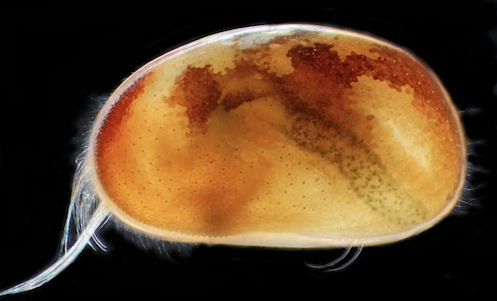
Left side view of a female Hemicypris posterotruncata, length 1.2 mm.
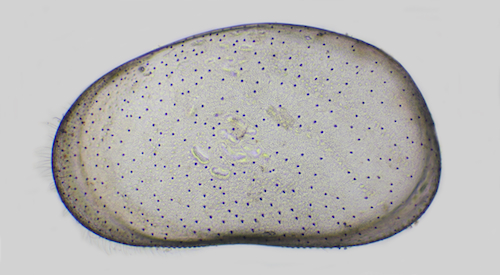
External view of a left valve of a female Hemicypris posterotruncata. Length 1165 microns.
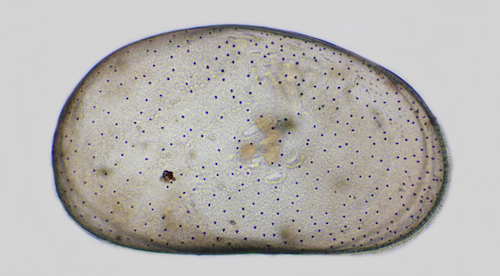
External view of a right valve of a female Hemicypris posterotruncata. Length 1189 microns.